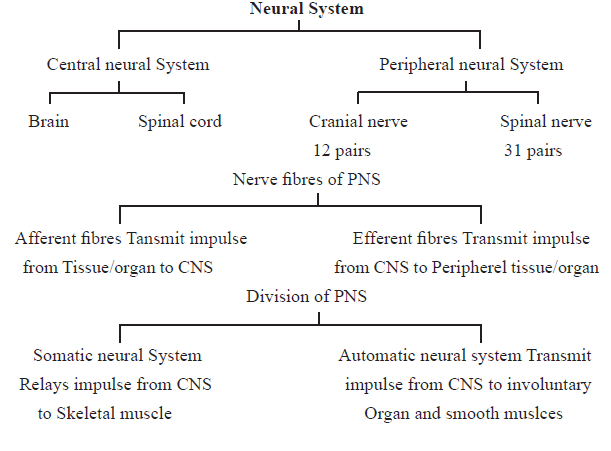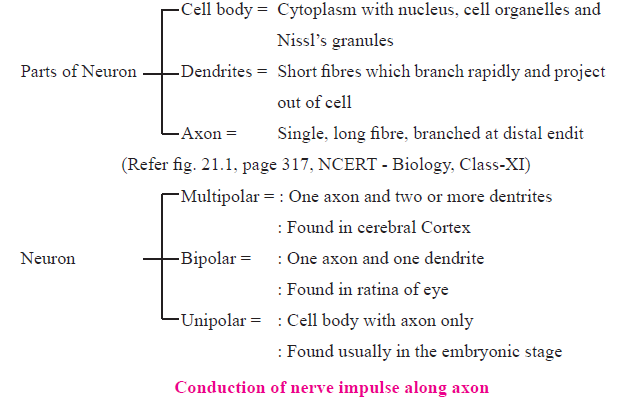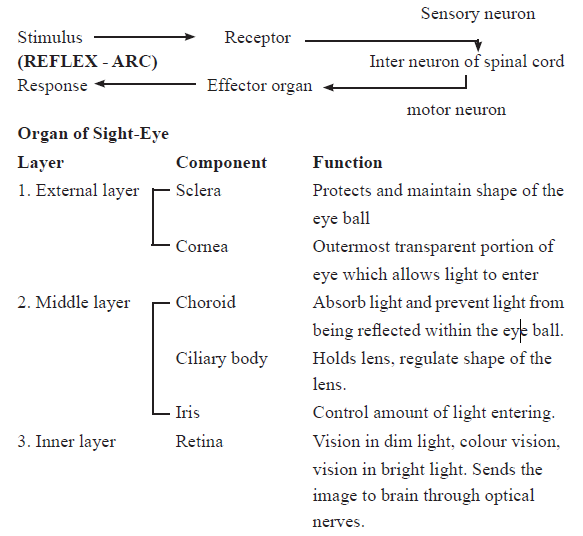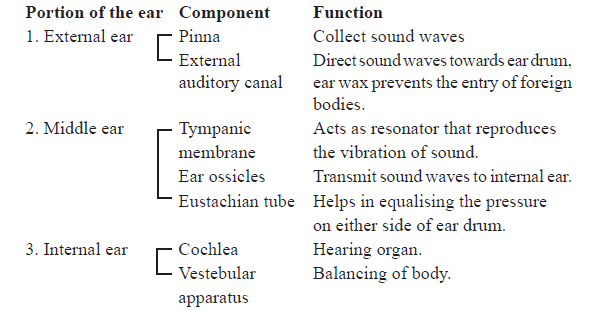Download CBSE Class 11 Biology Neural Control And Coordination Notes Set B in PDF format. All Revision notes for Class 11 Biology have been designed as per the latest syllabus and updated chapters given in your textbook for Biology in Class 11. Our teachers have designed these concept notes for the benefit of Class 11 students. You should use these chapter wise notes for revision on daily basis. These study notes can also be used for learning each chapter and its important and difficult topics or revision just before your exams to help you get better scores in upcoming examinations, You can also use Printable notes for Class 11 Biology for faster revision of difficult topics and get higher rank. After reading these notes also refer to MCQ questions for Class 11 Biology given on studiestoday
Revision Notes for Class 11 Biology Chapter 18 Neural Control and Coordination
Class 11 Biology students should refer to the following concepts and notes for Chapter 18 Neural Control and Coordination in Class 11. These exam notes for Class 11 Biology will be very useful for upcoming class tests and examinations and help you to score good marks
Chapter 18 Neural Control and Coordination Notes Class 11 Biology
Points To Remember
Coordination : Process through which two or more organs interact and complement the functions of one another surrounding the brain.
Action potential : A sudden change in the electrical charges in the plasma membrane of a nerve fibre.
Aqueous humour: The thin watery fluid that occupy space between lens and cornea in eye.
Blind spot : A spot on ratina which is free from rods and cones and lack the ability for vision.
Cerebrospinal fluid : An alkaline fluid present in between inner two layer of meninges, surrounding the brain and spinal cord.
Cerebellum : A part of hind brain that controls the balance and posture of the body.
Cochlea : A spirally coiled part of internal ear which is responsible for hearing.
Corpus callosum : A curved thick bundle of nerve fibres that joins two cerebral hemisphere.
Depolarisation : A condition when polarity of the plasma membrane of nerve fibre is reversed.
Endolymph: The fluid filled within membranous labyrinth.
Ecustachiantube : A tube which connect ear cavity with the pharynx.
Fovea : An area of highest vision on the ratina which contain only cones.
Meninges : Three sheets of covering of connective tissue wrapping the brain.
Grey Matter : This shows many convolutions which increase the amount of vital nerve tissue.
Medula oblongata : Posterior most part of the brain which is continuous with spinal cord and control respiration, heart rate,swallowing,vomiting.
Pons: Thick bundles of fibres on the ventral side of brain below cerebellum.
Foramen magnum :A big aperture in the skull posteriorly through which spinal cord emerges out.
Spinal cord : A tubular structure connected with medulla oblongata of brain and situated in the neural canal of the vertebral column, covered by meninges.
Synaptic cleft : A narrow fluid filled space which separates two membranes of the two neurons at the synapse.
Synaptic vesicles : These are membrane bound vesicles in the axoplasm of the axon terminal and these store neurotransmitter.
Neurotransmitter: These are chemicals stored in synaptic vesicles, diffuse to reach the membrane of next neuron for its stimulation.
Synapse : A physiological junction between axon of one neuron and dendrite of next neuron.
CNS-Central neural system
PNS-Peripheral neural system
ANS-Autonomic neural system


Polarised membrane/Resting Potential
In resting phase when neuron is not conducting an impulse, the axonal membrane is called polarised. This is due to difference in concentration of ions across the axonal membrane.
At Rest:
- Axoplasm inside the axon contain high cone. of K+ and low cone. of Na+.
- The fluid outside the axon contain low cone. of K+ and high cone. of Na+.
As a result the outer surface of axonal membrane is positively charged and inner surface is negatively charged. The electric potential difference across the resting plasma membrane is called resting potential.
Action Potential : When a nerve fibre is stimulated, the permeability of membrane to Na+ is greatly increased at the point of stimulus (rapid influx of Na+) and hence polarity of membrane is reversed and now membrane is said to be depolarised. The electric potential difference across the plasma membrane at that site is called action potential, which infact termed as nerve impulse.
Depolarisation is very rapid, so that conduction of nerve impulse along the entire length of axon occurs in fractions of second.
Transmission of Impulses at Synapse
(i) At electrical synapses :Here the membrane of pre and post-syneptic neuron are in very close proximity. Electric current can flow directly from one neuron into other across these synapses, like impule conduction along a single axon.
(ii) At chemical synapses :Here the membrane of pre and post-syneptic neuron are separated by fluid filled space called synaptic cleft. Neurotransmitter are involved here.
When an impulse arrives at the axon terminal, it stimulates the movement of the synaptic vesicles towards membrane and they fuse with the plsama membrane and release their neurotransmitter in the syneptic cleft. These chemicals bind to specific receptors, present on the post-syneptic membrane. Their binding opens ion channels and allow the entry of ion which generate new potential in post synaptic neuron.
Human brain :Human brain is the major portion of central neural system. Which is well protected by the skull.
The brain is surrounded by three cranial meninges -
(i) Duramater-outer alyer
(ii) Arachnoid-middle layer
(iii) Piamter-Inner layer-remain incontact with brain

Functions of pars of brain :
Cerebrum : Centre of intelligence, memory and imagination, reasoning, judgement, expression of will power.
Thalamus : Acts as relay centre to receive and transmit general sensation of pain, touch and temperature.
Hypothalamus : Centre for regulation of body temperature, urge for eating and drinking.
Midbrain: Responsible to coordinate visual reflexes and auditory reflexes.
Cerebellum : Maintains posture and equilibrium of the body as well as coordinates and regulates voluntary movement.
Pons :Relays impulses between medulla oblongata and cerebral hemisphere and between the hemisphere of cerebrum and cerebellum. It also heps to regulate breathing.
Medulla oblongata : Centre that control heart beat, breathing, swallowing, salivation, sneezing, vomitting and coughing.
Reflex action : It is spontaneous, autonomic and mechanical response to a stimulus that occurs at the level of spinal cord, without involvement of brain.
Reflex arc : The flow of nerve along the specific during reflex action. It consist of-
(a) A receptor
(b) An Afferent neuron (sensory neuron)
(c) An inter neuron
(d) An efferent neuron (motor neuron)
(e) An effector organ

Organ of Hearing-Ear

| CBSE Class 11 Biology The Living World Notes Set A |
| CBSE Class 11 Biology The Living World Notes Set B |
| CBSE Class 11 Biology Plant Kingdom Notes Set A |
| CBSE Class 11 Biology Plant Kingdom Notes Set B |
| CBSE Class 11 Biology Plant Kingdom Notes Set C |
| CBSE Class 11 Biology Animal Kingdom Notes Set A |
| CBSE Class 11 Biology Animal Kingdom Notes Set B |
| CBSE Class 11 Biology Animal Kingdom Notes Set C |
| CBSE Class 11 Biology Morphology Of Flowering Plants Notes Set A |
| CBSE Class 11 Biology Morphology Of Flowering Plants Notes Set B |
| CBSE Class 11 Biology Structural Organisation In Animals Notes Set A |
| CBSE Class 11 Biology Structural Organisation In Animals Notes Set B |
| CBSE Class 11 Biology Cell The Unit Of Life Notes Set A |
| CBSE Class 11 Biology Cell The Unit Of Life Notes Set B |
| CBSE Class 11 Biology Cell The Unit Of Life Notes Set C |
| CBSE Class 11 Biology Biomolecules Notes Set A |
| CBSE Class 11 Biology Biomolecules Notes Set B |
| CBSE Class 11 Biology Respiration In Plants Notes Set A |
| CBSE Class 11 Biology Respiration In Plants Notes Set B |
| CBSE Class 11 Biology Plant Growth And Development Notes Set A |
| CBSE Class 11 Biology Plant Growth And Development Notes Set B |
| CBSE Class 11 Biology Breathing And Exchange Of Gases Notes Set A |
| CBSE Class 11 Biology Breathing And Exchange Of Gases Notes Set B |
| CBSE Class 11 Biology Body Fluids And Circulation Notes Set A |
| CBSE Class 11 Biology Body Fluids And Circulation Notes Set B |
| CBSE Class 11 Biology Neural Control And Coordination Notes Set A |
| CBSE Class 11 Biology Neural Control And Coordination Notes Set B |
| CBSE Class 11 Biology Chemical Coordination and Integration Notes Set A |
| CBSE Class 11 Biology OTBA Guidance Document Set A |
| CBSE Class 11 Biology OTBA Guidance Document Set B |
CBSE Class 11 Biology Chapter 18 Neural Control and Coordination Notes
We hope you liked the above notes for topic Chapter 18 Neural Control and Coordination which has been designed as per the latest syllabus for Class 11 Biology released by CBSE. Students of Class 11 should download and practice the above notes for Class 11 Biology regularly. All revision notes have been designed for Biology by referring to the most important topics which the students should learn to get better marks in examinations. Our team of expert teachers have referred to the NCERT book for Class 11 Biology to design the Biology Class 11 notes. After reading the notes which have been developed as per the latest books also refer to the NCERT solutions for Class 11 Biology provided by our teachers. We have also provided a lot of MCQ questions for Class 11 Biology in the notes so that you can learn the concepts and also solve questions relating to the topics. We have also provided a lot of Worksheets for Class 11 Biology which you can use to further make yourself stronger in Biology.
You can download notes for Class 11 Biology Chapter 18 Neural Control and Coordination for latest academic session from StudiesToday.com
Yes, the notes issued for Class 11 Biology Chapter 18 Neural Control and Coordination have been made available here for latest CBSE session
There is no charge for the notes for CBSE Class 11 Biology Chapter 18 Neural Control and Coordination, you can download everything free of charge
www.studiestoday.com is the best website from which you can download latest notes for Chapter 18 Neural Control and Coordination Biology Class 11
Come to StudiesToday.com to get best quality topic wise notes for Class 11 Biology Chapter 18 Neural Control and Coordination

